Coercion aversive control - Study guides, Class notes & Summaries
Looking for the best study guides, study notes and summaries about Coercion aversive control? On this page you'll find 45 study documents about Coercion aversive control.
Page 2 out of 45 results
Sort by
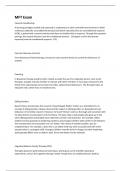
-
MFT Exam Questions and 100% Correct Verified Answers 2023 Rated A+
- Exam (elaborations) • 10 pages • 2023
-
- $13.99
- + learn more
Classical Conditioning: A learning paradigm studied and practiced in a laboratory or other controlled environment in which a stimulus called the unconditioned stimulus (US) which naturally elicits an unconditioned response (UCR), is paired with a neutral stimulus that does not initially elicit a response. Through the repeated pairings, the neutral stimulus (now the conditioned stimulus - CS) begins to elicit the desired response (now the conditioned response - CR). Coercion (Aversive Contr...
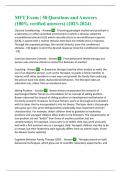
-
MFT Exam | 50 Questions and Answers (100% verified answers) (2023-2024)
- Exam (elaborations) • 9 pages • 2023
- Available in package deal
-
- $11.49
- + learn more
MFT Exam | 50 Questions and Answers (100% verified answers) ()
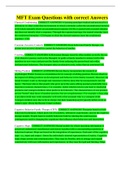
-
MFT Exam Questions with correct Answers
- Exam (elaborations) • 7 pages • 2023
- Available in package deal
-
- $10.49
- + learn more
MFT Exam Questions with correct Answers Classical Conditioning Coercion (Aversive Control. Coaching Sibling Position Cognitive Behavior Family Therapy (CBT. Cognitive Maps: Collaborative Language Family Therapy: Communication Theory Contextual Family Therapy: Collaborative Couples Therapy). Concurrent Couples Therapy: ABC-X Family Crisis Model: Autopoietic Systems:. Circularity (Circular Causality): Cybernetics:). Beavers - Timberlawn Model: Centripetal: Circ...
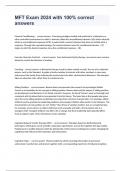
-
MFT Exam 2024 with 100% correct answers
- Exam (elaborations) • 8 pages • 2024
-
- $12.49
- + learn more
Classical Conditioning: - correct answer A learning paradigm studied and practiced in a laboratory or other controlled environment in which a stimulus called the unconditioned stimulus (US) which naturally elicits an unconditioned response (UCR), is paired with a neutral stimulus that does not initially elicit a response. Through the repeated pairings, the neutral stimulus (now the conditioned stimulus - CS) begins to elicit the desired response (now the conditioned response - CR). Coercion...
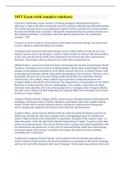
-
MFT Exam (with complete solutions)
- Exam (elaborations) • 7 pages • 2023
- Available in package deal
-
- $9.49
- + learn more
Classical Conditioning: correct answers A learning paradigm studied and practiced in a laboratory or other controlled environment in which a stimulus called the unconditioned stimulus (US) which naturally elicits an unconditioned response (UCR), is paired with a neutral stimulus that does not initially elicit a response. Through the repeated pairings, the neutral stimulus (now the conditioned stimulus - CS) begins to elicit the desired response (now the conditioned response - CR). Coercion (A...
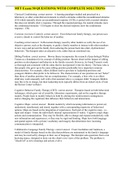
-
MFT Exam| 50 QUESTIONS| WITH COMPLETE SOLUTIONS
- Exam (elaborations) • 6 pages • 2023
- Available in package deal
-
- $11.49
- + learn more
Classical Conditioning: correct answer: A learning paradigm studied and practiced in a laboratory or other controlled environment in which a stimulus called the unconditioned stimulus (US) which naturally elicits an unconditioned response (UCR), is paired with a neutral stimulus that does not initially elicit a response. Through the repeated pairings, the neutral stimulus (now the conditioned stimulus - CS) begins to elicit the desired response (now the conditioned response - CR). Coercion (...
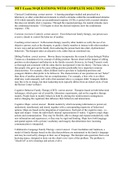
-
MFT Exam| 50 QUESTIONS| WITH COMPLETE SOLUTIONS
- Exam (elaborations) • 6 pages • 2023
- Available in package deal
-
- $11.49
- + learn more
Classical Conditioning: correct answer: A learning paradigm studied and practiced in a laboratory or other controlled environment in which a stimulus called the unconditioned stimulus (US) which naturally elicits an unconditioned response (UCR), is paired with a neutral stimulus that does not initially elicit a response. Through the repeated pairings, the neutral stimulus (now the conditioned stimulus - CS) begins to elicit the desired response (now the conditioned response - CR). Coercion (...
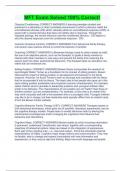
-
MFT Exam Solved 100% Correct!
- Exam (elaborations) • 7 pages • 2023
- Available in package deal
-
- $10.99
- + learn more
MFT Exam Solved 100% Correct!
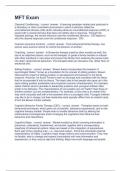
-
MFT Exam Questions with complete solution 2023
- Exam (elaborations) • 7 pages • 2023
- Available in package deal
-
- $13.49
- + learn more
MFT Exam Questions with complete solution 2023 Classical Conditioning: - correct answer A learning paradigm studied and practiced in a laboratory or other controlled environment in which a stimulus called the unconditioned stimulus (US) which naturally elicits an unconditioned response (UCR), is paired with a neutral stimulus that does not initially elicit a response. Through the repeated pairings, the neutral stimulus (now the conditioned stimulus - CS) begins to elicit the desired response...
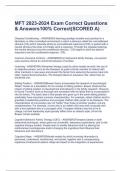
-
MFT 2023-2024 Exam Correct Questions & Answers100% Correct(SCORED A)
- Exam (elaborations) • 7 pages • 2023
- Available in package deal
-
- $10.99
- + learn more
Classical Conditioning: - ANSWERSA learning paradigm studied and practiced in a laboratory or other controlled environment in which a stimulus called the unconditioned stimulus (US) which naturally elicits an unconditioned response (UCR), is paired with a neutral stimulus that does not initially elicit a response. Through the repeated pairings, the neutral stimulus (now the conditioned stimulus - CS) begins to elicit the desired response (now the conditioned response - CR). Coercion (Aversive...

How did he do that? By selling his study resources on Stuvia. Try it yourself! Discover all about earning on Stuvia


